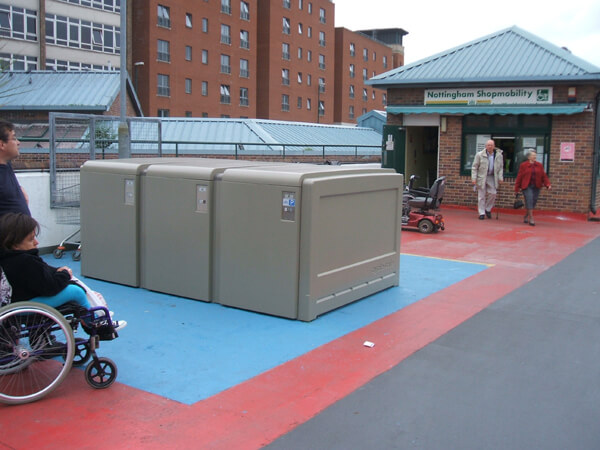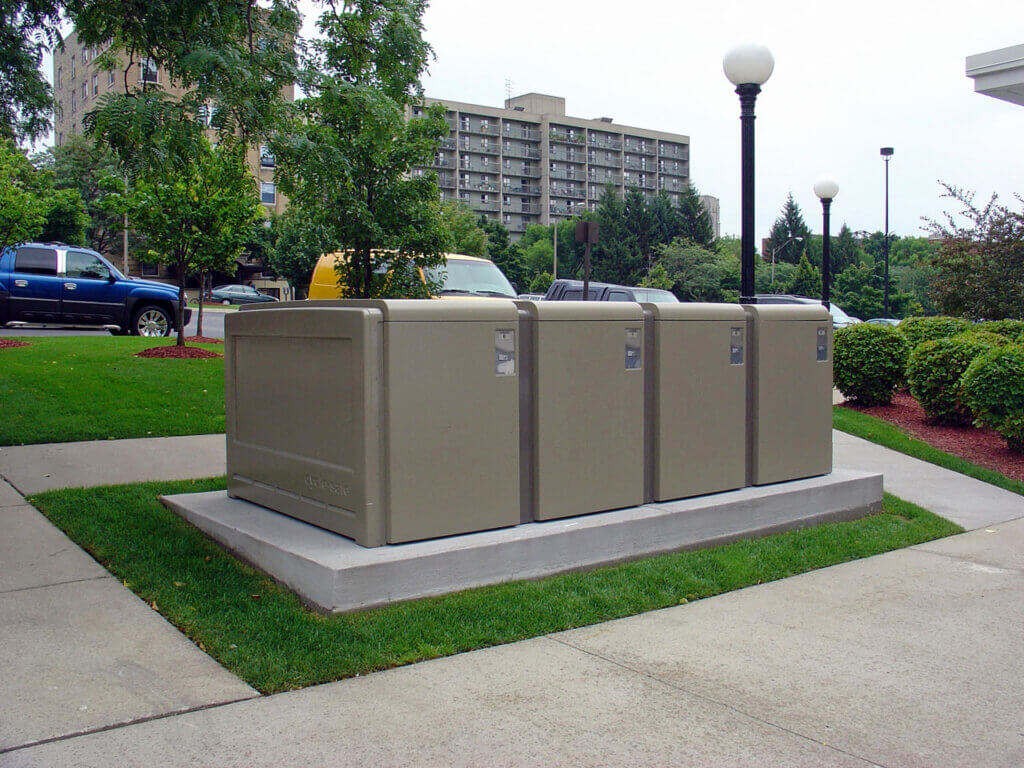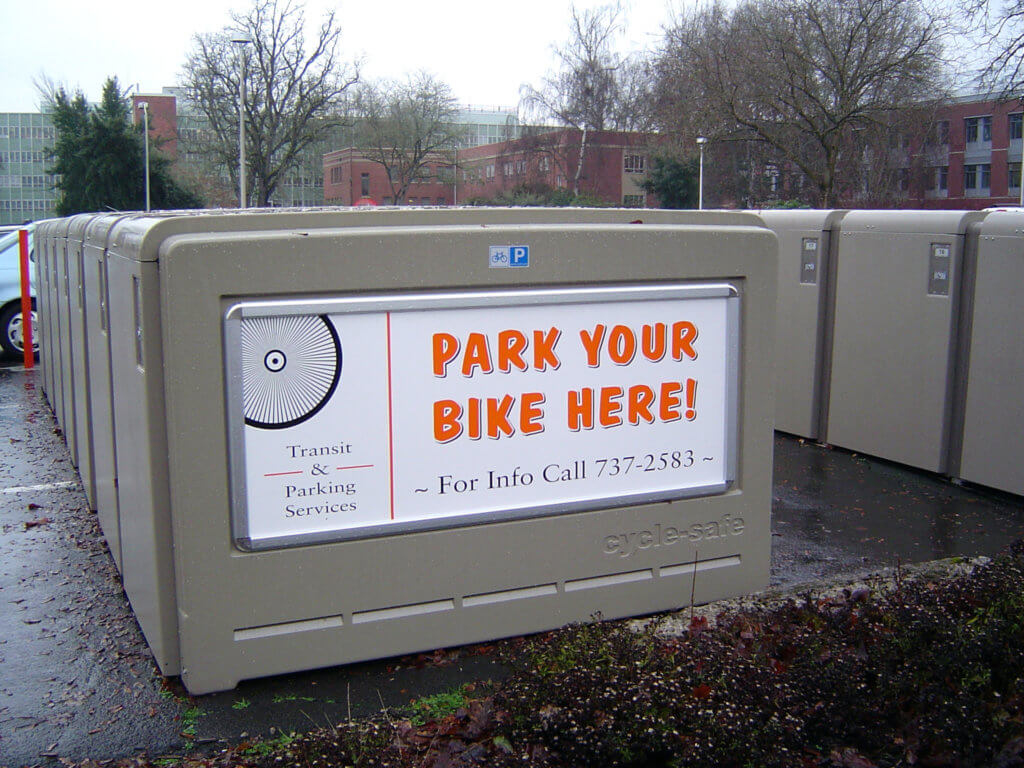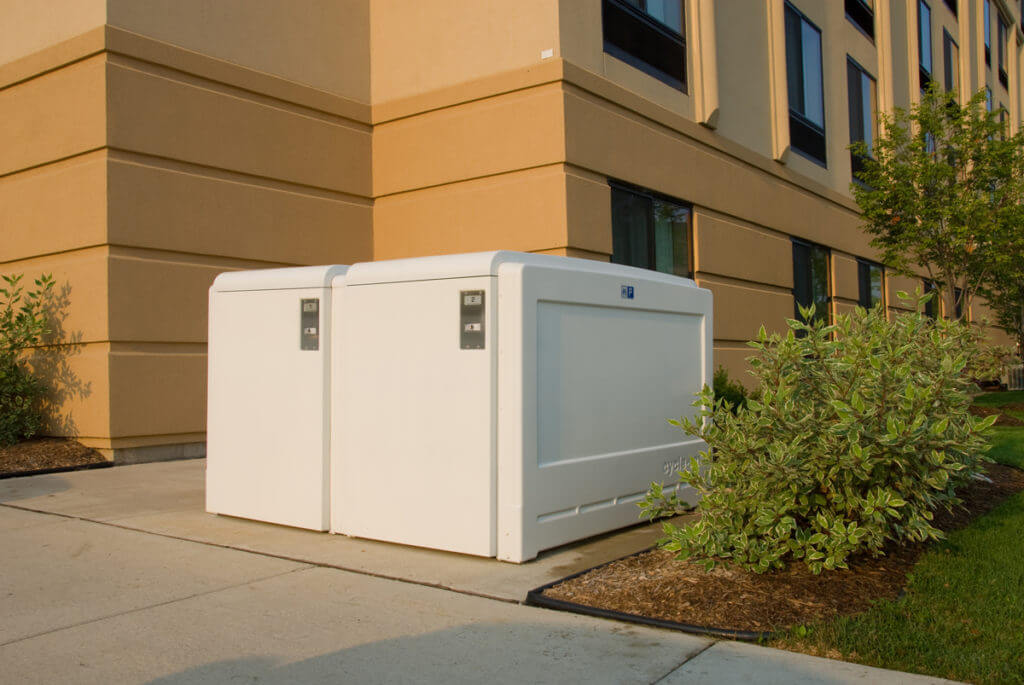
A good bike locker installation should be well-designed and functional, with an emphasis on security, accessibility, and aesthetics. A great bike locker installation should offer a range of features and benefits that enhance the experience for cyclists and provide secure and convenient bicycle storage. While the specific appearance may vary depending on factors like location and architectural style, here are some characteristics that contribute to what a good bike locker installation should look like:
Clean and Organized Layout
- Design the layout of the locker installation to maximize space efficiency and accommodate the expected number of users.
- Bike lockers should be located near entrances, bike paths, or transit stations for easy access and natural flow for riders as they arrive and depart the space.
- Bike lockers should be neatly arranged, keep a layout that optimizes space while maintaining a clean and organized appearance.
- Multiple, short term banks are advantageous over long banks as they allow for more access points for users to circulate in and out of the lockers. They also increase the number of bike locker end panels available for signage, wayfinding and advertising.
- Modular double-tier bike lockers may be installed for secure, high-density bike parking where there is sufficient height clearance.
- Avoid placing bike lockers against walls or other structures. Doing so limits aisle-way access for cyclists and creates dead end spaces that can be uncomfortable for some users, and encourages debris build up. This application will also reduce visible end panels, eliminating potential for end panel display revenue.
Need help with layout and design dimension info?
Safety and Security
- A well designed bike locker installation is done in well-lit areas, adding appropriate lighting as necessary to enhance security and visibility, while discouraging unauthorized access.
- Security cameras or surveillance systems may be installed to deter theft and vandalism, aid in the investigation of any incidents, and provide cyclists with peace of mind.
- Lockers should incorporate robust locking mechanisms, such as tamper-proof T-handle locks or integrated, keyless electronic locks—or allow the use of cyclist-provided secure locking mechanisms—such as heavy-duty padlocks and U-locks.
- Lockers should be made of durable materials that deter tampering and vandalism, and constructed in a way that defeats unauthorized and brute-force entry.

Accessibility and Pathways
- Bike locker banks should be placed where they are easily accessible to cyclists, with clear pathways leading to and from the lockers.
- Aisles between rows and ends of locker banks should be at least 72 inches. This will maintain adequate space between lockers to allow users to easily access their lockers and maneuver their bikes.
- High traffic areas should have more than one entrance.
- Bollards should be installed to isolate bike locker banks from adjacent vehicle traffic lanes and parking spots, creating a buffer for cyclists and their gear.
- ADA-compliant pathways and clearances should be incorporated where appropriate to ensure accessibility for users with disabilities.
Read more about layout and design recommendations

User-Friendly Features
- Top-notch bike locker installations also include the installation of amenities such as benches, bike repair stations, and air pumps nearby to enhance the user experience.
- A good bike locker installation also provides bike racks for short-term bike parking, as well as a place for locker users to stage their bikes when arriving or preparing to leave.
- A great bike locker installation also incorporates bike lockers that provide additional parking space for larger bicycles, including extension, cargo, and recumbent bikes.
- Electrical outlets inside lockers offer eBike users the convenience of charging their bike within a secure bike parking environment.
- Hooks and storage bins inside the locker provide cyclists with a way to store gear in an organized fashion.
Regulatory Compliance
- Be sure to research and comply with local building codes, zoning regulations, and any other relevant legal requirements that may affect your bike locker installation.
- Ensure your bike parking plans meet any capacity requirements for Class I and Class II bike parking.
Locker Pad Preparation
- Bike lockers should be installed on freshly poured 4-inch-thick reinforced concrete pads. Asphalt requires specialty mounting materials, if you are installing on a non-improved surface discuss this with your bike parking professional.
- Pads should be sloped to promote water run-off, but the slope should not exceed one degree. Locker doors may not open sufficiently if slope is too great.
- Locker units should be surrounded by an access surface that may be concrete, asphalt, pavers, or other improved surfaces. Alternatively, elevate concrete pads six inches above grade and blend a one-foot-wide apron to grade for surface water drainage.

Weather Protection
- Bike locker design should provide protection against rain, snow, UV rays, and other weather conditions to prevent damage to bicycles and cyclists’ gear.
- Bike locker design should channel water away from the locker interior and also prevent rainwater from draining between lockers.
- Shelters, overhangs, and awnings can provide additional comfort for cyclists.

Signage, Wayfinding, and Advertising
- Clear and informative signage should be displayed to guide users to bike lockers and provide instructions on locker usage and rules.
- Display panels should be installed on the ends of each locker bank for signage, wayfinding, locker instructions, or as placement for advertising media.

Aesthetic Integration & Landscaping
- The design of the lockers should be visually appealing and complement the architectural style of the surrounding area or building.
- Custom colors of bike lockers and bike locker components can be specified to complement architectural structures or organizational branding.
- The use of other site furnishings and landscaping can help integrate the locker installation into its environment.
- The use of landscaping and greenery can enhance the appearance of the installation and create an inviting atmosphere.
- Landscaping and site furnishing elements not only can create visually pleasing and functional space, but also help define pathways and isolate cyclists from vehicle traffic.

Maintenance and Cleaning
- A good bike locker installation uses bike lockers that have graffiti-resistant surfaces or coatings that help mitigate vandalism and provide easy clean-up.
- A great bike locker installation also has available water and electricity nearby for use to periodically wash or power-wash all bike lockers.
Ultimately, a great bike locker installation should strike a balance between functionality, security, aesthetics, and environmental considerations. It should provide a secure and convenient storage solution for cyclists while enhancing the overall look and feel of the surrounding area. A well-designed and well-maintained bike locker installation can encourage more people to use bicycles for transportation, promote cycling safety, and contribute to a cleaner and healthier environment.
When you’re ready to start planning your next bike locker installation, get in touch with one of our bike locker planning experts. We’re here to help.
